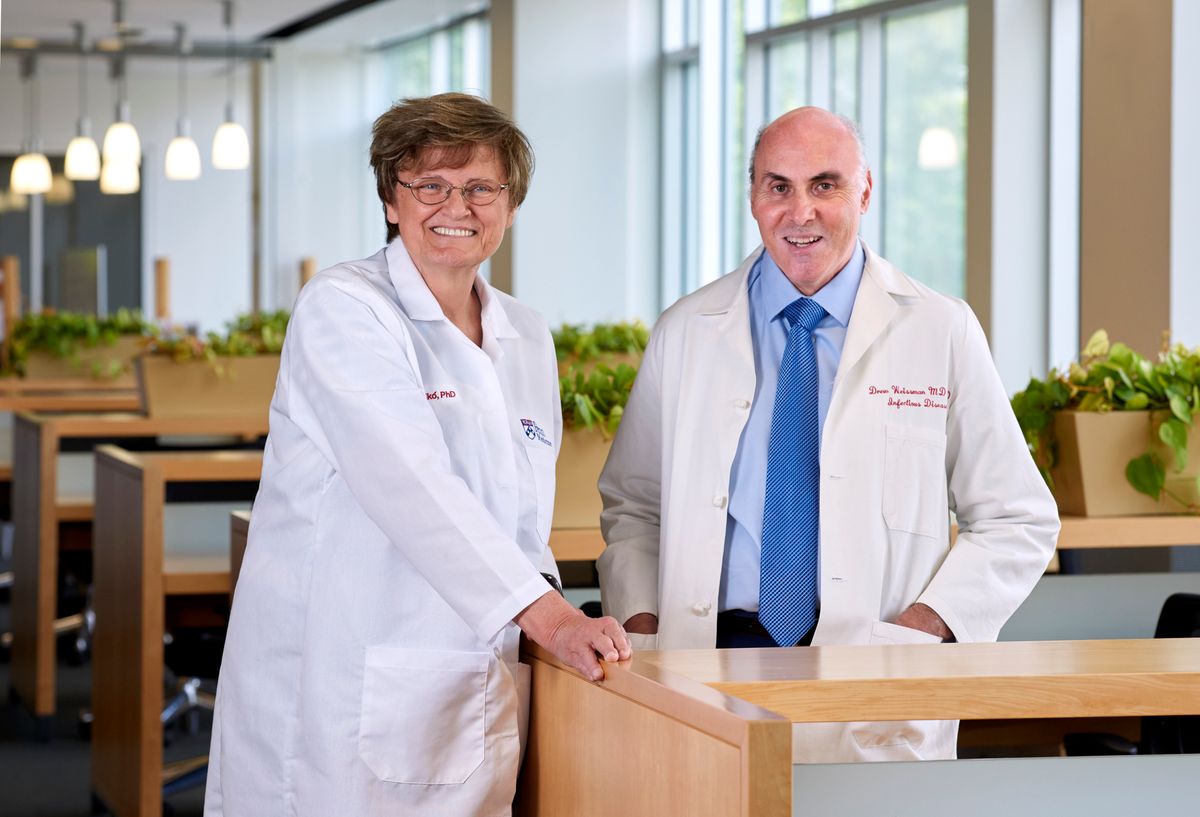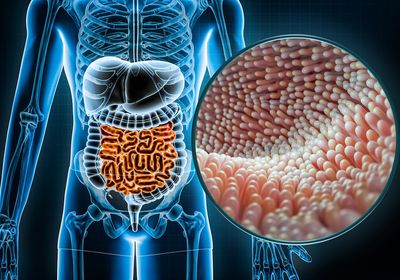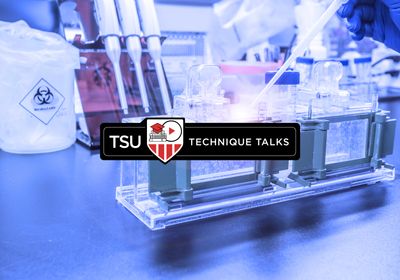ABOVE: Katalin Karikó (left) and Drew Weissman (right) and won the Nobel Prize for their contributions to RNA biology and mRNA-based therapeutics. Ill. Niklas Elmehed © Nobel Prize Outreach
Katalin Karikó, a biochemist at BioNTech, Szeged University, and the University of Pennsylvania (UPenn), and Drew Weissman, an immunologist at UPenn, won this year’s Nobel Prize in Physiology or Medicine “for their discoveries concerning nucleoside base modifications that enabled the development of effective mRNA vaccines against COVID-19,” the Nobel Assembly at the Karolinska Institute announced today (October 2). Their discoveries enabled the rapid development of effective vaccines during one of the greatest public health emergencies in modern times.
“This year’s Nobel Prize recognizes their basic science discovery that fundamentally changed our understanding of how mRNA interacts with the immune system and had a major impact on society during the recent pandemic,” said Thomas Perlmann, secretary general of the 2023 Nobel Assembly, during the press conference.

Vaccines are one of the strongest weapons built to tackle viruses. They give the immune system a head start, training it to recognize and attack pathogens. The earliest antiviral vaccines, such as those against polio and yellow fever, used dead or weakened viruses to induce robust immune protection. Advancements in molecular biology gave way to targeted vaccination strategies that train the immune system using snippets of the viral genome that encode specific viral components, such as proteins located on the viruses’ surfaces. Depending on the type, the vaccine either directs the body to produce proteins that trigger the formation of antibodies, as with the human papillomavirus vaccine, or triggers an immune response in reaction to the presence of viral proteins delivered in a viral vector, as with the Ebola vaccine.1,2
Both whole and targeted viral strategies use large-scale cell culture, which can be slow and resource intensive, and therefore not ideal during a fast emerging global pandemic. This drove many researchers to explore whether they could offload this labor to the body, which naturally and efficiently transforms nucleic acids into proteins.
In the 1980s, researchers developed a cell culture-free system, in vitro transcription, for producing mRNA. William Studier’s team at Brookhaven National Laboratory discovered that the T7 RNA polymerase, from the T7 bacteriophage, quickly induced RNA transcription in vitro.3 Although a promising approach, it needed a system upgrade. In vitro transcribed mRNA was unstable and thus required sophisticated delivery vehicles. Furthermore, mRNA made in vitro produced limited protein and caused a significant inflammatory reaction.
See also “The Promise of mRNA Vaccines”
Karikó and Weissman started working together in 1997 when they were both at UPenn. Karikó wanted to develop mRNA-based therapeutics, while Weissman hoped to develop a vaccine against human immunodeficiency virus-1 (HIV-1). Bolstered by Karikó’s background in RNA biochemistry and Weissman’s expertise in immunology, they decided to find out how mRNA interacts with the immune system. Specifically, they wanted to tease apart the molecular mechanisms that caused the inflammatory response to mRNA transcribed in vitro, which is not observed with mRNA from mammalian cells.
When the researchers delivered in vitro transcribed mRNA encoding an HIV-1 structural protein to dendritic immune cells in a dish, it triggered a large innate immune response.4 Subsequent studies dissecting the signaling pathways responsible for this response revealed that different patterns of nucleic acids, such as unmethylated CpG motifs, activated Toll-like receptors (TLRs) expressed on dendritic cells to trigger downstream immune pathways.5,6 Karikó and Weissman found that in vitro transcribed mRNA activated TLR3, leading to a cytokine response.7
In 2005, nearly 15 years before the COVID-19 pandemic, Karikó and Weissman made an important breakthrough. Since nucleobases in RNA from mammalian cells undergo chemical modifications, unlike in vitro transcribed mRNA, Karikó and Weissman wondered whether this lack of modifications explained the immune reaction. To test their hypothesis, they introduced a variety of base modifications to in vitro transcribed mRNA, which they delivered to dendritic immune cells.8 These slight tweaks to the system nearly abolished inflammatory signaling.
In a subsequent study, Karikó and Weissman demonstrated that introducing a particular modification to in vitro transcribed mRNA increased protein yield.9 In the same study, they ran in vivo experiments in mice, which demonstrated the therapeutic potential of the platform.
“Karikó and Weissman made fundamental discoveries of the importance of base modifications in mRNA, which eliminated a major obstacle to mRNA-based clinical applications,” said Perlmann during the press conference.
mRNA-based approaches for developing vaccines are also modular. When a new viral strain emerges, researchers can respond quickly by plugging in the updated sequence. “That is one of the great advantages of this platform is that it is flexible and fast,” said Gunilla Karlsson-Hedestam, chair of the 2023 Nobel Assembly.
The effects of Karikó and Weissman’s discoveries extend beyond the COVID-19 pandemic. Since their foundational studies in the 2000s, interest in mRNA technology grew rapidly. Now, several mRNA-based vaccines exist, including those targeted to SARS-CoV-2, Zika virus, and MERS-CoV.10,11 Many researchers are excited about the future of mRNA technologies, from the development of cancer vaccines and vaccines against other infections to novel method for therapeutic protein delivery.
See also “Optogenetics and mRNA Vaccines Net Lasker Awards”
Karikó is the 13th woman to win the prize in Physiology or Medicine. Over the last few years, her scientific story has received a lot of attention in the wake of the successful vaccine rollout. She struggled to gain recognition for her vision of mRNA therapeutics, and, in 2013, left UPenn for an industry position at the RNA pharmaceuticals company BioNTech. In 2020, BioNTech partnered with Pfizer to develop an RNA vaccine against SARS-CoV-2, and later that year, the first vaccinations were administered. Now, more than 13 billion COVID-19 vaccine doses have been administered globally.
Without the persistence and determination of Karikó and Weissman to follow their vision of mRNA-based therapeutics, who knows what the world would look like today.
References
- Stanley M. Tumour virus vaccines: Hepatitis B virus and human papillomavirus. Philos Trans R Soc Lond B Biol Sci. 2017;372(1732):20160268.
- Woolsey C, Geisbert TW. Current state of Ebola virus vaccines: A snapshot. PLoS Pathog. 2021;17(12):e1010078.
- Studier FW, Moffatt B. Use of bacteriophage T7 RNA polymerase to direct selective high-level expression of cloned genes. J Mol Biol. 1986;189(1):113-130.
- Weissman D, et al. HIV gag mRNA transfection of dendritic cells (DC) delivers encoded antigen to MHC class I and II molecules, causes DC maturation, and induces a potent human in vitro primary immune response. J Immunol. 2000;165(8):4710-4717.
- Hemmi H, et al. A Toll-like receptor recognizes bacterial DNA. Nature. 2000;408(6813):740-755.
- Akira S, Hemmi, H. Recognition of pathogen-associated molecular patterns by TLR family. Immunol Lett. 2003;85(2):85-95.
- Karikó K, et al. mRNA is an endogenous ligand for Toll-like receptor 3. J Biol Chem. 2004;279(13):12542-12550.
- Karikó K, et al. Suppression of RNA recognition by Toll-like receptors: The impact of nucleoside modification and the evolutionary origin of RNA. Immunity. 2005;23(2):165–175.
- Karikó K, et al. Incorporation of pseudouridine into mRNA yields superior nonimmunogenic vector with increased translational capacity and biological stability. Mol Ther. 2008;16(11):1833-1840
- Pardi N, et al. Zika virus protection by a single low-dose nucleoside-modified mRNA vaccination. Nature. 2017;543(7644):248-251.
- Pallesen J, et al. Immunogenicity and structures of a rationally designed prefusion MERS-CoV spike antigen. Proc Natl Acad Sci U S A. 2017;114(35):E7348-E7357.








